Things to See in the Languedoc: Historic
Cities: Millau and the New Millau Bridge 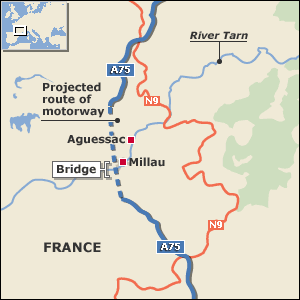  Millau's
most famous feature is its new bridge. Information about
the rest of Millau will follow, but here is some information
about the bridge. Millau's
most famous feature is its new bridge. Information about
the rest of Millau will follow, but here is some information
about the bridge.
This bridge is the world's highest road
bridge. Opened in January 2005, it spans the valley of the
River Tarn, a 2.5 km wide gorge dividing two plateaux in
France's rugged Massif Central. Part of the motorway from
Paris to Barcelona, it enables motorists to drive through
the sky, often above the clouds.
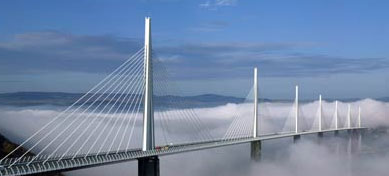  The Millau bridge crosses the
Tarn valley at its lowest point, linking the causse du
Larzac to the causse rouge. The
bridge is within the perimeter of the Grands Causses regional
natural park. The Millau bridge crosses the
Tarn valley at its lowest point, linking the causse du
Larzac to the causse rouge. The
bridge is within the perimeter of the Grands Causses regional
natural park.
The bridge is the last link on the A75
autoroute, providing a continuous high-speed route from Paris
through Clermont-Ferrand to Béziers. Many tourists heading
to southern France and Spain follow this route because it
is direct and mostly toll free. The A75 (la Méridienne) is
a developmental project which will speed up and reduce the
cost of car travel from Paris southwards, and it is free for
the 340 km between Clermont-Ferrand and Béziers.
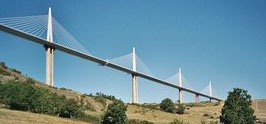 

 Built
in steel-and-concrete the bridge is more than 300m (984ft)
high - taller than the Eiffel Tower. It floats 270 meters
(891 feet) above the Tarn valley for a 2.5 kilometers (1.6
miles), its concrete and steel pillars soaring high above
the morning fog. Built
in steel-and-concrete the bridge is more than 300m (984ft)
high - taller than the Eiffel Tower. It floats 270 meters
(891 feet) above the Tarn valley for a 2.5 kilometers (1.6
miles), its concrete and steel pillars soaring high above
the morning fog.
The construction of the bridge began in December 2001, using
innovative techniques. Norman Foster (Lord Foster), The architect,
said his cable-stayed bridge was designed to have the "delicacy
of a butterfly". Seven slender piers support the roadway,
rising into graceful pylons bound to the bridge by what have
been described as cobwebs of steel. It is the spectacular
result of collaboration between architects and engineers
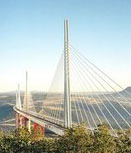  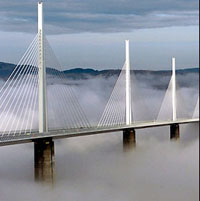  The
bridge has the optimum span between cable-stayed columns.
It isdelicate, transparent, and uses the minimum material.
Each of its sections spans 350 meters. The columns range in
height from 75 meters to 235 meters - with the masts rising
a further 90 meters above the road deck. To accommodate the
expansion and contraction of the concrete deck, each column
splits into two thinner, more flexible columns below the roadway,
forming an A-frame above deck level. This structure creates
a dramatic silhouette. The
bridge has the optimum span between cable-stayed columns.
It isdelicate, transparent, and uses the minimum material.
Each of its sections spans 350 meters. The columns range in
height from 75 meters to 235 meters - with the masts rising
a further 90 meters above the road deck. To accommodate the
expansion and contraction of the concrete deck, each column
splits into two thinner, more flexible columns below the roadway,
forming an A-frame above deck level. This structure creates
a dramatic silhouette.
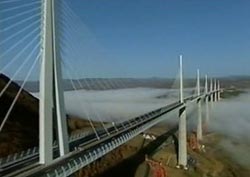  The
Bridge has become a major tourist attraction in its own right
and a source of pride for Millau, which believes many more
tourists will come to admire one of theengineering wonders
of the 21st Century. (Millau is best known outside France
as the place where Jose Bové dismantled a McDonald's
restaurant) The
Bridge has become a major tourist attraction in its own right
and a source of pride for Millau, which believes many more
tourists will come to admire one of theengineering wonders
of the 21st Century. (Millau is best known outside France
as the place where Jose Bové dismantled a McDonald's
restaurant)
  Built in three years at a cost of €394
million (£272 million), the bridge is not merely a gateway
to the Riviera floating over what had been one of the nation's
most notorious bottlenecks, but as an embodiment of Gallic
flair, a stylish marriage of the functional and the aesthetic.
President Jacques Chirac, who inaugurated it said: "It is
a magnificent example, in the long and great French tradition,
of audacious works of art, a tradition begun at the turn of
the 19th and 20th centuries by the great Gustave Eiffel. "The
French people are rightly proud of the feats
accomplished here - feats which speak for France. A modern
France, an enterprising, successful France, a France which
invests in its future." The project was financed privately
by the French construction group Eiffage - the same group
that built the Eiffel Tower. They financed the project in
return for the right to collect receipts from a bridge toll
for 75 years. The French government has the right to assume
control of the bridge from 2044, if it proves extremely profitable. Built in three years at a cost of €394
million (£272 million), the bridge is not merely a gateway
to the Riviera floating over what had been one of the nation's
most notorious bottlenecks, but as an embodiment of Gallic
flair, a stylish marriage of the functional and the aesthetic.
President Jacques Chirac, who inaugurated it said: "It is
a magnificent example, in the long and great French tradition,
of audacious works of art, a tradition begun at the turn of
the 19th and 20th centuries by the great Gustave Eiffel. "The
French people are rightly proud of the feats
accomplished here - feats which speak for France. A modern
France, an enterprising, successful France, a France which
invests in its future." The project was financed privately
by the French construction group Eiffage - the same group
that built the Eiffel Tower. They financed the project in
return for the right to collect receipts from a bridge toll
for 75 years. The French government has the right to assume
control of the bridge from 2044, if it proves extremely profitable.
An estimated 10,000 vehicles use it every day, rising to 25,000 per day at the height of summer.
Toll fees for motorists when it opened were 4.90 euros ($6.50) in winter and 6.50 euros ($8.62) in summer. Lorries (US trucks) pay 24.30 euros ($32.24) year-round.

Statistics
- Cost: 394m euros (£272m; $524m)
- Statistics: Length: 2.5 km
- Road Height: 280 m
- Highest point: 343m (1,125ft)
- Weight: about 36,000 tonnes
- Start of Construction: 16 October 2001
- Completion Date: January 2005
- Architectural Design: Foster and Partners
- Design Concept: SETRA
- Structural Engineering: EEG Simecsol and Greisch
- Contractor: Eiffage Construction
- Co-Contractor: Eiffel Construction
- Fabricator: Freyssinet (stay cables)
- Launching Enerpac
- Formwork: PERI Formwork and Scaffolding
Click on the following link for a good route
from Paris to the Languedoc which passes over the new Millau
Bridge
|

